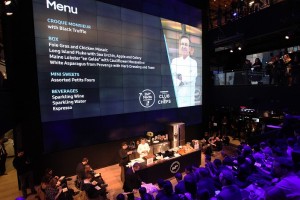Samsung 837’s 360 Meals
(Photo: Donald Bowers/Getty Images for Samsung)
From brick-and-mortar to mobile to social, today’s consumers are used to operating in a seamless world. Pretty much every industry has had to adapt to these consumer expectations, including food retailers and restaurants.
Often, the conversation about seamless consumer experiences is focused around e-commerce and mobile technology, but what about the other types of technology that have been developed around this concept? Cognitive computing, virtual reality and robotics are just some examples of the kinds of consumer-facing technologies businesses are using to create the most seamless consumer experience possible. So how are retailers and restaurants incorporating these technologies into their operations?
Cognitive computing
Cognitive computing is a new era of smart technology that uses machine learning to decipher consumer preferences and use that information to curate personalized experiences. The most famous use of cognitive computing is IBM’s Watson technology, but the field is growing and now there are opportunities for retailers to incorporate the technology into the shopping experience, both online and in stores.
For example, three-year-old firm CognitiveScale brought its cognitive cloud software to the National Retail Federation’s BIG Show earlier this year, displaying its software optimized for the retail industry that allows food and other types of retailers to deliver what the company calls a “hyper-personalized” shopping experience. Through its software, the company helps retailers create both physical and digital profiles of their customers to allow for personalized in-store shopper engagement.
CognitiveScale looks to help retailers offer “micro-experiences that are powered by a deep understanding of [the customer’s] profile allowing, the retailer to market to them as an individual rather than as a broad market segment,” the company told GeoMarketing.
With Deloitte reporting that the cognitive computing market is on track to exceed $50 billion in 2018, compared with $1 billion in 2014, there is little doubt that the industry will see more from the cognitive computing sector in the near future.
Virtual reality
Virtual reality is another developing technology that industries are finding new applications for. Retailers are seeing the value of virtual reality as a way to create more of an experience for shoppers venturing out to stores, and even restaurants are finding ways to use virtual reality technology to their advantage.
At Samsung 837, a New York City retail experience meant to put the electronics company’s products on display, cooking demonstrations and classes take place in a kitchen that features smart home devices and virtual reality technology. The first virtual reality cooking demo took place there with the help of Chef Daniel Boulud, who filmed a 360-degree video at his restaurant DANIEL that was viewed by consumers who were also treated to the smells of Croque Monsieur sandwiches that were being made on-site. The event provided an opportunity to put a spotlight on the virtual reality technology and to feature Boulud’s restaurant and menu.
Robotics
Robotics is not a new technology — it’s not even necessarily new in the retail sector. Retailers have made use of robotic technology in manufacturing and the e-commerce fulfillment process for years. But with recent advancements in robotics technology, industries including food retail are finding new ways to incorporate robots into their operations in ways that are more apparent to customers.
For example, Bossa Nova Robotics works with big-box and other types of retailers to provide robots that are fully autonomous and have the ability to work with store associates inside physical stores. The robots collect and process data about the products on shelves. The company’s technology can navigate around shoppers and employees to help in the restocking process.
“Inventory inaccuracy, empty shelves or misplaced items result in significant loss of revenue for retailers each year. Bossa Nova’s technology helps recapture those lost sales by collecting high-quality, time-sensitive data that provides detailed, accurate and actionable information to help store staff improve retail shelf compliance,” CEO Martin Hitch said.
Another example of robotics technology being used in stores comes from 4D Retail Technology. The company’s 4D Space Genius robotic imaging platform moves through stores via Segway taking images of every product on a store’s shelves in ultra-high resolution and 3D to create a 3D map of the store in less than 60 minutes. The technology helps retailers get a clear sense of where every single product is located within a store and also processes information about price tag discrepancies, missing price tags and empty shelves.
From advanced machine learning to smart robotics, technology is becoming a very broad term in the food industry. And as consumers’ lives delve deeper into today’s connected world, these technologies are bound to be joined by many others in the future.
__________________________________________________
If you enjoyed this article, join SmartBrief’s email list for more stories about the food and beverage industry. We offer 14 newsletters covering the industry from restaurants to food manufacturing.
